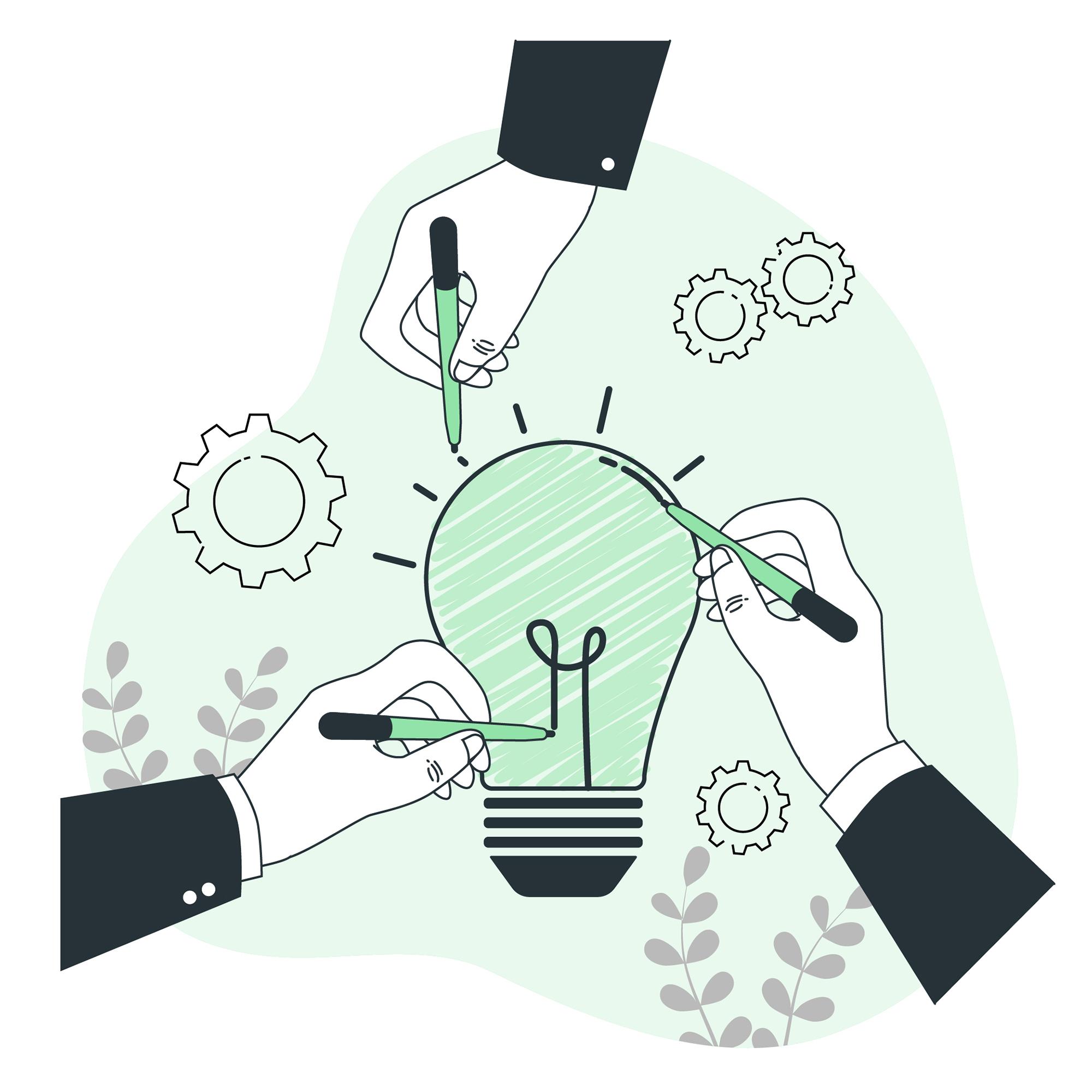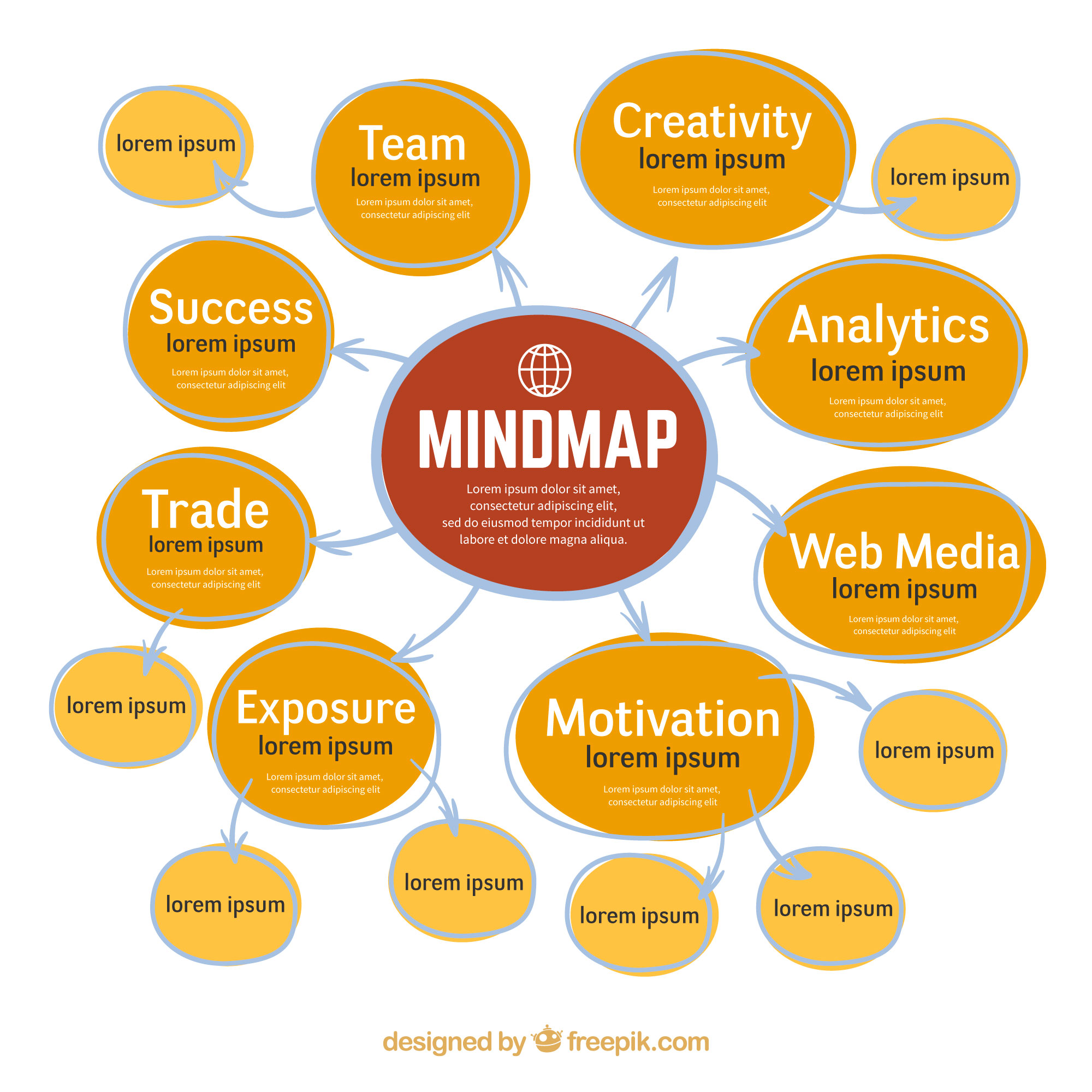Brainstorming generates ideas through free-form discussion, while mind mapping visually organizes ideas into interconnected diagrams.
Did you know that the average person has about 50,000 thoughts a day? With so many ideas flowing through our minds, it’s crucial to have effective techniques for harnessing and organizing them. This is where brainstorming and mind mapping come into play. Brainstorming is a process of generating ideas without evaluation or organization, while mind mapping is a visual method of organizing information around a central point. The two techniques have their own unique benefits and are often used together in the creative process to unleash the full potential of our ideas.
Key Takeaways:
- Brainstorming is a technique for generating ideas without evaluation or organization.
- Mind mapping is a visual method of organizing information around a central point.
- Combining brainstorming and mind mapping enhances the creative process.
- Brainstorming promotes quantity over quality, while mind mapping helps make connections between ideas.
- Both techniques have applications in various fields, including business, education, technology, and design.
Understanding Brainstorming

Brainstorming is a method used to generate new ideas by discussing in groups. It encourages free thinking and focuses on quantity over quality to foster collaboration and innovative solutions. Effective brainstorming starts with defining a clear topic and creating a non-judgmental environment where all ideas are valued, no matter how unconventional.
During brainstorming sessions, criticism and judgment are temporarily suspended to allow for a free flow of creativity. This approach promotes teamwork, strengthens relationships, and enhances problem-solving skills by encouraging diverse perspectives and alternative solutions. To ensure successful sessions, it’s essential to set a time limit, use visual aids for organization, and document all ideas for future reference.
Techniques for Effective Brainstorming:
- Define a clear and specific topic or problem
- Create a safe and non-judgmental environment
- Encourage all participants to share their ideas
- Suspend criticism and judgment during the session
Benefits of Brainstorming:
- Increased creativity
- Team-building and collaboration
- Improved problem-solving skills
Exploring Mind Mapping

Mind mapping is a technique used to organize information visually, making it easier to understand complex ideas by creating connections between them. It’s widely applicable in areas like strategic planning and project management, where it helps visualize goals, tasks, and their relationships for better organization and clarity. This method enhances understanding of project scope and facilitates planning for successful completion.
Additionally, mind mapping is effective for note-taking and learning. By using visual cues and associations, individuals can retain and recall information more easily. It allows for the capture and organization of key points and ideas, making study sessions more structured and efficient.
Let’s take a closer look at the advantages of mind mapping:
- Enhanced Clarity: Mind maps provide a clear, visual representation of complex ideas and relationships, making them easier to comprehend and navigate.
- Improved Understanding of Complex Concepts: By breaking down complex concepts into smaller, interconnected components, mind mapping helps individuals grasp and analyze intricate information more effectively.
- Enhanced Memory Retention: The visual and spatial nature of mind maps aids in memory retention, making it easier for individuals to recall information when needed.
Mind mapping is a versatile tool that can be utilized in various contexts to enhance productivity, understanding, and creativity. Whether it’s for personal organization, project planning, or learning, mind mapping offers a structured yet flexible approach to information organization and processing.
The Relationship Between Brainstorming and Mind Mapping
Brainstorming and mind mapping are closely intertwined and frequently utilized together in the creative process. While brainstorming serves as a means to generate a plethora of ideas, mind mapping plays a crucial role in organizing and establishing connections between those ideas. The visual nature of mind maps greatly enhances brainstorming sessions by improving clarity, fostering collaboration, enabling effective communication, and optimizing efficiency. Mind mapping offers a structured framework that complements brainstorming, leading to more efficient idea generation and problem-solving.
When brainstorming, individuals or groups engage in a free-flowing ideation process that encourages the exploration of diverse concepts and perspectives. However, the results of brainstorming sessions can often be overwhelming, with an abundance of ideas that may lack structure. This is where mind mapping proves invaluable. By visually representing ideas in a centralized format, mind maps provide a clear overview of the brainstormed concepts and facilitate the identification of relationships and connections between ideas. This structured approach enhances brainstorming by creating a visual roadmap that guides the exploration and evaluation of ideas.
The benefits of mind mapping in improving brainstorming are multi-fold. Here are some ways in which mind mapping enhances the brainstorming process:
- Clarity: Mind mapping visually organizes ideas, making complex concepts more digestible and easier to understand.
- Collaboration: Mind maps provide a shared platform that encourages collaboration and enables individuals to build upon each other’s ideas.
- Communication: The visual nature of mind maps facilitates effective communication by enabling participants to easily grasp and discuss ideas.
- Efficiency: Mind mapping streamlines the brainstorming process by offering a structured framework that guides idea generation, evaluation, and selection.
Incorporating mind mapping into brainstorming sessions cultivates a more productive and focused environment for idea generation. By leveraging the power of visual organization and structure, mind mapping enhances creativity, promotes effective collaboration, and aids in the development of innovative solutions.
The Benefits of Both Techniques in the Workplace
In the workplace, both brainstorming and mind mapping have their own unique benefits. Brainstorming in a group setting promotes team-building, harmony, and coordination among team members. It encourages collaboration and helps generate diverse ideas that can lead to innovative solutions.
On the other hand, mind mapping can be done individually and offers several advantages for individuals. It allows for personal goal achievement and self-expression, enabling individuals to organize their thoughts in a clear and structured manner. Mind mapping also facilitates the analysis of complex information, helping individuals gain a deeper understanding of the subject matter.
Benefits of Brainstorming in a Group
- Promotes team-building and collaboration
- Fosters diverse perspectives and ideas
- Encourages open communication and active participation
- Enhances problem-solving skills
Advantages of Mind Mapping for Individuals
- Allows for personal goal achievement
- Facilitates self-expression and creativity
- Organizes thoughts and enhances clarity
- Aids in analyzing complex information
In summary, both brainstorming and mind mapping have distinct benefits in the workplace. Brainstorming promotes collaboration and idea generation, while mind mapping enables individuals to organize their thoughts and analyze information. By harnessing the power of both techniques, organizations can foster teamwork, creativity, and productivity, achieving their goals while supporting the growth of their employees.
Brainstorming vs. Mind Mapping: Comparing the Techniques
When it comes to idea generation and problem-solving, two popular techniques often come to mind: brainstorming and mind mapping. While they share common goals, there are key differences between the two that make each approach unique and valuable in its own way.
Brainstorming: The Art of Creative Expression
Brainstorming is a dynamic and free-flowing technique that encourages individuals or groups to generate a plethora of ideas. It’s an excellent way to kickstart the creative process and explore various possibilities. During a brainstorming session, participants engage in open and non-judgmental discussions, allowing ideas to flow freely without constraints or evaluation.
Some of the key characteristics of brainstorming include:
- Focus on idea generation
- Encouragement of diverse perspectives
- Emphasis on quantity over quality
Brainstorming provides a safe and collaborative environment where thoughts and concepts can be shared openly. This approach fosters creativity, encourages teamwork, and stimulates innovative thinking.
Mind Mapping: Connecting the Dots
Mind mapping, on the other hand, is a visual technique that focuses on organizing and connecting ideas. It revolves around a central theme or concept, from which various branches and sub-branches emanate, forming a structured representation of information. Mind maps provide a holistic view of relationships between ideas, fostering clarity and comprehension.
The main characteristics of mind mapping include:
- Creation of visual networks of ideas
- Identification of connections and associations
- Structured and organized representation of information
Mind mapping is a powerful tool for individuals who prefer a visual approach to idea organization. It enhances comprehension, aids in memory retention, and promotes creative problem-solving through the visualization of interconnected concepts.
Comparing Brainstorming and Mind Mapping
Now let’s compare these two techniques side by side:
| Brainstorming | Mind Mapping |
|---|---|
| Focuses on idea generation | Focuses on organizing and connecting ideas |
| Free-flowing and unrestricted | Structured visual representation |
| Promotes quantity over quality | Promotes clarity and comprehension |
While brainstorming encourages the generation of diverse ideas without restrictions, mind mapping provides a visual framework to organize and explore these ideas further. Both techniques are complementary, with brainstorming serving as the initial spark of creative expression and mind mapping acting as the means to structure and connect the generated ideas.
By understanding the differences and strengths of each technique, individuals and teams can harness the full potential of both brainstorming and mind mapping in their creative endeavors. The combination of these approaches leads to effective idea generation, enhanced problem-solving, and the fostering of creativity.
Applications of Brainstorming and Mind Mapping in Various Fields
Brainstorming and mind mapping are versatile techniques that find applications across a range of fields, each contributing to enhanced creativity, collaboration, and problem-solving.
In Business:
- Team-building: Brainstorming fosters a collaborative environment, encouraging team members to contribute diverse ideas and perspectives.
- Strategic planning: Both brainstorming and mind mapping help organizations develop and refine strategies, leveraging collective intelligence.
- Decision-making processes: Brainstorming generates a wide array of options, while mind mapping aids in evaluating and organizing those options.
In Education:
- Facilitating learning: Mind mapping helps students visualize relationships between concepts, improving understanding and knowledge retention.
- Simplifying complex concepts: By breaking down complex ideas into manageable chunks, mind mapping makes learning more accessible and engaging.
In Technology and Design:
- Fueling innovation: Brainstorming generates a multitude of ideas, while mind mapping facilitates the organization and visualization of those ideas, fostering innovative thinking.
- Visualizing relationships between ideas: Mind mapping provides a clear visual representation of connections and links, aiding in the design process and problem-solving.
These techniques have proven to be invaluable tools in their respective fields, enabling individuals and organizations to think creatively, collaborate effectively, and tackle complex challenges.
| Field | Brainstorming | Mind Mapping |
|---|---|---|
| Business | Team-building, strategic planning, decision-making processes | Organizing ideas, evaluating options, visualizing strategies |
| Education | Nurturing creativity, stimulating discussion | Enhancing learning, simplifying complex concepts |
| Technology and Design | Generating innovative ideas | Visualizing relationships, aiding the design process |
The Power of Using Both Techniques Together
Combining brainstorming and mind mapping maximizes creativity and problem-solving potential. Begin with a brainstorming session to generate various ideas, fostering creativity and diverse perspectives. Then, transition to mind mapping to organize and structure these ideas visually, identifying connections and breaking down complex information.
Mind mapping helps represent relationships between ideas clearly, aiding in prioritization and comprehension. By integrating both techniques, you benefit from diverse idea generation and enhanced organization, understanding, and analysis.
Take a look at the following table to see how combining brainstorming and mind mapping can enhance the creative process:
| Brainstorming | Mind Mapping |
|---|---|
| Generates a multitude of ideas | Organizes and structures ideas |
| Encourages free thinking and creativity | Visualizes relationships between ideas |
| Facilitates collaboration and team-building | Promotes clarity and understanding |
| Fosters innovation and problem-solving | Identifies connections and patterns |
As you can see, by integrating both techniques, you can maximize the benefits of brainstorming and mind mapping. This combination promotes holistic thinking, improves decision-making, and leads to more innovative solutions.
So, whether you’re embarking on a creative project, solving a complex problem, or seeking fresh perspectives, remember the power of combining brainstorming and mind mapping. Embrace the synergy of these techniques, and watch your ideas flourish.
Mind Mapping and Brainstorming: Catalysts for Creativity in Different Fields
Mind mapping and brainstorming are powerful techniques that unleash creativity in various fields. They provide a platform for generating and organizing ideas, fostering innovation and problem-solving. Let’s explore how mind mapping and brainstorming are applied in different domains:
1. Mind Mapping and Brainstorming in Business
In the business world, mind mapping and brainstorming play crucial roles in promoting collaboration, team-building, and strategic planning. By applying these techniques, teams can generate fresh ideas, identify connections, and develop innovative solutions that drive the growth and success of organizations.
2. Mind Mapping and Brainstorming in Education
In the field of education, mind mapping and brainstorming enhance learning experiences by simplifying complex concepts and promoting engagement. Teachers and students can use these tools to express their ideas, organize thoughts, and establish relationships between different topics or subjects, resulting in improved knowledge retention and critical thinking skills.
3. Mind Mapping and Brainstorming in Technology and Design
In the realms of technology and design, mind mapping and brainstorming fuel innovation and provide a creative platform for generating and visualizing ideas. These techniques help professionals in these industries to explore possibilities, identify patterns, and prototype solutions, leading to breakthrough products, user-centric designs, and technological advancements.
Through mind mapping and brainstorming, creativity flourishes in a variety of fields. These techniques unlock the potential for collaboration, innovation, and problem-solving, enabling individuals and organizations to thrive and succeed.
| Field | Aspects |
|---|---|
| Business | Collaboration, team-building, strategic planning |
| Education | Learning, simplifying concepts, engagement |
| Technology and Design | Innovation, idea generation, visualization |
Conclusion
Brainstorming and mind mapping offer distinct yet complementary approaches to idea generation and organization. While brainstorming fosters creativity and encourages the free flow of ideas, mind mapping provides a structured method for visualizing and connecting those ideas. By combining these techniques, individuals and teams can harness the strengths of both processes, leading to more effective problem-solving and innovation.
By integrating brainstorming and mind mapping into the creative process, individuals and teams can capitalize on the strengths of each technique. Brainstorming generates a wealth of ideas, while mind mapping organizes and structures those ideas into a coherent framework. This synergistic approach enhances productivity, fosters collaboration, and ultimately leads to the development of innovative solutions and breakthroughs.
FAQ
What’s the difference between brainstorming and mind mapping?
Brainstorming is a technique used to generate ideas without evaluation or organization, while mind mapping is a method of visually organizing information around a central point.
How can I brainstorm effectively?
Techniques for effective brainstorming include defining a clear topic, encouraging all participants to share ideas, and avoiding judgment or criticism.
What are the benefits of mind mapping?
The advantages of mind mapping include enhanced clarity, better understanding of complex concepts, and improved memory retention.
How does mind mapping improve brainstorming?
The visual nature of mind maps enhances brainstorming sessions by improving clarity, collaboration, communication, and efficiency.
How does brainstorming benefit the workplace?
Brainstorming in a group setting promotes team-building, harmony, and coordination among team members. It encourages collaboration and helps generate diverse ideas.
What advantages does mind mapping offer for individuals?
Mind mapping can be done individually and allows for personal goal achievement and self-expression. It helps individuals organize their thoughts and analyze complex information.
What are the main differences between brainstorming and mind mapping?
Brainstorming is focused on generating new ideas, while mind mapping is focused on creating relationships between ideas. Brainstorming is a more free-flowing, unrestricted technique, while mind mapping provides a structured visual representation.
What are the applications of brainstorming and mind mapping in various fields?
In business, these techniques are used in team-building, strategic planning, and decision-making processes. In education, they facilitate learning, simplify complex concepts, and enhance memory retention. In technology and design, they fuel innovation and help visualize the relationships between ideas.
How can I use both brainstorming and mind mapping together?
By integrating these techniques, you can unleash the full potential of the creative process. Start with a dynamic brainstorming session to generate a multitude of ideas, then use mind mapping to organize and structure those ideas.
How do brainstorming and mind mapping contribute to creativity in different fields?
In business, they foster collaboration, team-building, and strategic planning. In education, they enhance learning, simplify complex concepts, and promote engagement. In technology and design, they fuel innovation and provide a platform for generating and organizing ideas.
Source Links
- https://www.mindomo.com/blog/mind-mapping-vs-brainstorming/
- https://www.linkedin.com/pulse/brainstorming-vs-mind-mapping-shoptrend-com
- https://pediaa.com/what-is-the-difference-between-brainstorming-and-mind-mapping/
Image Credits
Featured Image By – jannoon028 on Freepik
Image 1 By – storyset on Freepik
Image 2 By – Freepik








